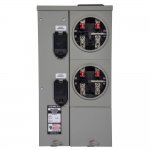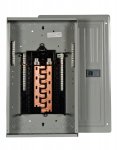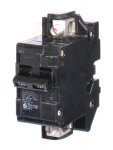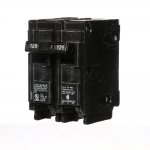cubgirl
Member
- Location
- madison, AL
Hi everyone,
first, let me state that i'm not an electrical professional. i'm a retired engineer but not electrical (industrial & aerospace). i posted these questions at another forum & i think they may be getting too technical for those guys. i hope you all don't mind my asking here.
i have a building, zoned both commercial and residential. i renovated it 2009 & had to meet commercial specs: ADA building, electric, HVAC, etc. it has 2 units but only one 200 amp panel (i upgraded electrical in 2009 and everything was new: service entrance cable, all circuits, etc).
it's currently vacant so i decided use this opportunity to split the utilities so the tenants pay utility bills, not me. i hired an electrical company for the job and requested that they install a new gang meter outside and two 125 amp breaker panels in each unit. they agreed to this but after job was done, i realized they had not met my specs. what they did was leave the old 200 amp, 40 space/circuit panel (siemen's G4040B1200 or G4040B1200CU or G4040L1200 or G4040L1200CU not sure how it's configured) with about 13 empty spaces (uncovered), all circuits are unlabeled and the original 200 amp main breaker was removed (its space uncovered). a 100 amp main breaker was installed on the bus and it does break the entire panel. in the 2nd unit, they installed a new 100 amp breaker panel (siemen's P2020B1100CU) which is also unlabeled, but every space is covered.
before the job began, i had emailed them the specs for a new tankless H2O heater that i bought and planned to install upstairs after the job was done (it requires a 125 amp panel with a 60 amp DP & #6-2 wire). a new H2O heater is necessary this unit for total separation of the utilities. i was specific about the panel size and breaker requirement. however, i was just guessing that 125 amps should be fed to both units.
after realizing they'd installed two 100 amp panels, i became concerned because my requirements weren't met. after researching, i decided to do load calculations on the two units. the results are that unit #1 requires a minimum of 150 amps and the unit #2 requires 125 amps, minimum. so 125 amps for unit #1 was incorrect but it was better than the 100 amps they provided.
i'd like to attach my load calculations to get feedback (do they look correct?) and ask the professionals if load calculations should have been done by the contractor to determine panels and feeder sizes? if the calcs had been done beforehand, this situation could've been avoided. the other forum told me load calcs are NEVER done for residential; and for commercial buildings, an engineer, not the electrician, perform the calculations. any advice on that?
i assume 200 amps can be distributed to 125 amp and 150 amp main breaker panels based on feeder wire size, thermal rating and material. during the job, i asked about the feeders and the contractor told me they were 2/0 and could support 125 amps. however, since but i was misled about panel amps, i assume the feeder wires are not rated for more than 100 amps.
these calculations were pretty easy to do and i'm not sure why the electrician didn't just plug in the numbers and install the correct size panels and feeders.
i've come to the conclusion that the only way to fix this is to hire someone to install a 150 amp feeder to unit #1 and replace the 100 amp main breaker with a 150 amp breaker, if possible. unit #2 will need both a new feeder and new panel, both rated at 125 amp, minimum. i think the gang meters can be left alone since i have 200 amp service.
is there a more elegant solution out there that i'm missing? that'd be great but unlikely.
thank so much for any advice and help you can provide & please forgive that i'm not a professional. :ashamed1:
cubgirl
P.S. i had to convert the spreadsheets to pdf to upload.
first, let me state that i'm not an electrical professional. i'm a retired engineer but not electrical (industrial & aerospace). i posted these questions at another forum & i think they may be getting too technical for those guys. i hope you all don't mind my asking here.
i have a building, zoned both commercial and residential. i renovated it 2009 & had to meet commercial specs: ADA building, electric, HVAC, etc. it has 2 units but only one 200 amp panel (i upgraded electrical in 2009 and everything was new: service entrance cable, all circuits, etc).
it's currently vacant so i decided use this opportunity to split the utilities so the tenants pay utility bills, not me. i hired an electrical company for the job and requested that they install a new gang meter outside and two 125 amp breaker panels in each unit. they agreed to this but after job was done, i realized they had not met my specs. what they did was leave the old 200 amp, 40 space/circuit panel (siemen's G4040B1200 or G4040B1200CU or G4040L1200 or G4040L1200CU not sure how it's configured) with about 13 empty spaces (uncovered), all circuits are unlabeled and the original 200 amp main breaker was removed (its space uncovered). a 100 amp main breaker was installed on the bus and it does break the entire panel. in the 2nd unit, they installed a new 100 amp breaker panel (siemen's P2020B1100CU) which is also unlabeled, but every space is covered.
before the job began, i had emailed them the specs for a new tankless H2O heater that i bought and planned to install upstairs after the job was done (it requires a 125 amp panel with a 60 amp DP & #6-2 wire). a new H2O heater is necessary this unit for total separation of the utilities. i was specific about the panel size and breaker requirement. however, i was just guessing that 125 amps should be fed to both units.
after realizing they'd installed two 100 amp panels, i became concerned because my requirements weren't met. after researching, i decided to do load calculations on the two units. the results are that unit #1 requires a minimum of 150 amps and the unit #2 requires 125 amps, minimum. so 125 amps for unit #1 was incorrect but it was better than the 100 amps they provided.
i'd like to attach my load calculations to get feedback (do they look correct?) and ask the professionals if load calculations should have been done by the contractor to determine panels and feeder sizes? if the calcs had been done beforehand, this situation could've been avoided. the other forum told me load calcs are NEVER done for residential; and for commercial buildings, an engineer, not the electrician, perform the calculations. any advice on that?
i assume 200 amps can be distributed to 125 amp and 150 amp main breaker panels based on feeder wire size, thermal rating and material. during the job, i asked about the feeders and the contractor told me they were 2/0 and could support 125 amps. however, since but i was misled about panel amps, i assume the feeder wires are not rated for more than 100 amps.
these calculations were pretty easy to do and i'm not sure why the electrician didn't just plug in the numbers and install the correct size panels and feeders.
i've come to the conclusion that the only way to fix this is to hire someone to install a 150 amp feeder to unit #1 and replace the 100 amp main breaker with a 150 amp breaker, if possible. unit #2 will need both a new feeder and new panel, both rated at 125 amp, minimum. i think the gang meters can be left alone since i have 200 amp service.
is there a more elegant solution out there that i'm missing? that'd be great but unlikely.
thank so much for any advice and help you can provide & please forgive that i'm not a professional. :ashamed1:
cubgirl
P.S. i had to convert the spreadsheets to pdf to upload.





